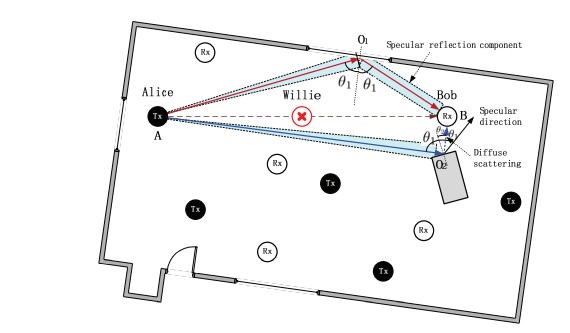Covert Wireless Communication in IoT Network: From AWGN Channel to THz Band
Objective
The primary idea is to improve covertness and to decrease SNR wall at Willie with actively modifying signals under the molecular absorption peaks in the THz spectrum.
Abstract
We demonstrated that covert communication is still possible in this occasion by utilizing the reflection or diffuse scattering from a rough surface. From the physical-layer security perspective, covert communication can enhance the security of IoT network from the bottom layer. Covert communication can prevent an adversary from knowing that a transmission has occurred between two users. In this paper, we consider covert wireless communications in an IoT network with dense deployment, where an IoT device experiences not only the background noise, but also the aggregate interference from other Tx devices.
Our results show that, in a dense IoT network with lower frequency AWGN channels, when the distance between Alice and the adversary Willie , Alice can reliably and covertly transmit O(log2 √ n) bits to Bob in n channel uses. In an IoT network with THz (Terahertz) Band, covert communication is more difficult because Willie can simply place a receiver in the narrow beam between Alice and Bob in order to detect or block their LOS communications. We demonstrated that covert communication is still possible in this occasion by utilizing the reflection or diffuse scattering from a rough surface. From the physical-layer security perspective, covert communication can enhance the security of IoT network from the bottom layer.
keywords: Internet of Things; Physical-layer Security; Covert Communication; AWGN Channel; THz Band
NOTE: Without the concern of our team, please don't submit to the college. This Abstract varies based on student requirements.
Block Diagram

Specifications
Software Requirements:
MATLAB R2018a or above
Hardware Requirements:
Operating Systems:
• Windows 10
• Windows 7 Service Pack 1
• Windows Server 2019
• Windows Server 2016
Processors:
Minimum: Any Intel or AMD x86-64 processor
Recommended: Any Intel or AMD x86-64 processor with four logical cores and AVX2 instruction set support
Disk:
Minimum: 2.9 GB of HDD space for MATLAB only, 5-8 GB for a typical installation
Recommended: An SSD is recommended A full installation of all MathWorks products may take up to 29 GB of disk space
RAM:
Minimum: 4 GB
Recommended: 8 GB
Learning Outcomes
- Introduction to Matlab
- What is EISPACK & LINPACK
- How to start with MATLAB
- About Matlab language
- Matlab coding skills
- About tools & libraries
- Application Program Interface in Matlab
- About Matlab desktop
- How to use Matlab editor to create M-Files
- Features of Matlab
- Basics on Matlab
- Basics of wireless communications
- How system modal can be formed in Matlab.
- Construction of algorithm according to system modal
- Analyzing and visualization of plots.
- Phases of data transmission:
- Generation of input signal
- Construction of transmitter
- Formation of channel
- Construction of receiver
- How to extend our work to another real time applications
- Project development Skills
- Problem analyzing skills
- Problem solving skills
- Creativity and imaginary skills
- Programming skills
- Deployment
- Testing skills
- Debugging skills
- Project presentation skills
- Thesis writing skills





 Paper Publishing
Paper Publishing
